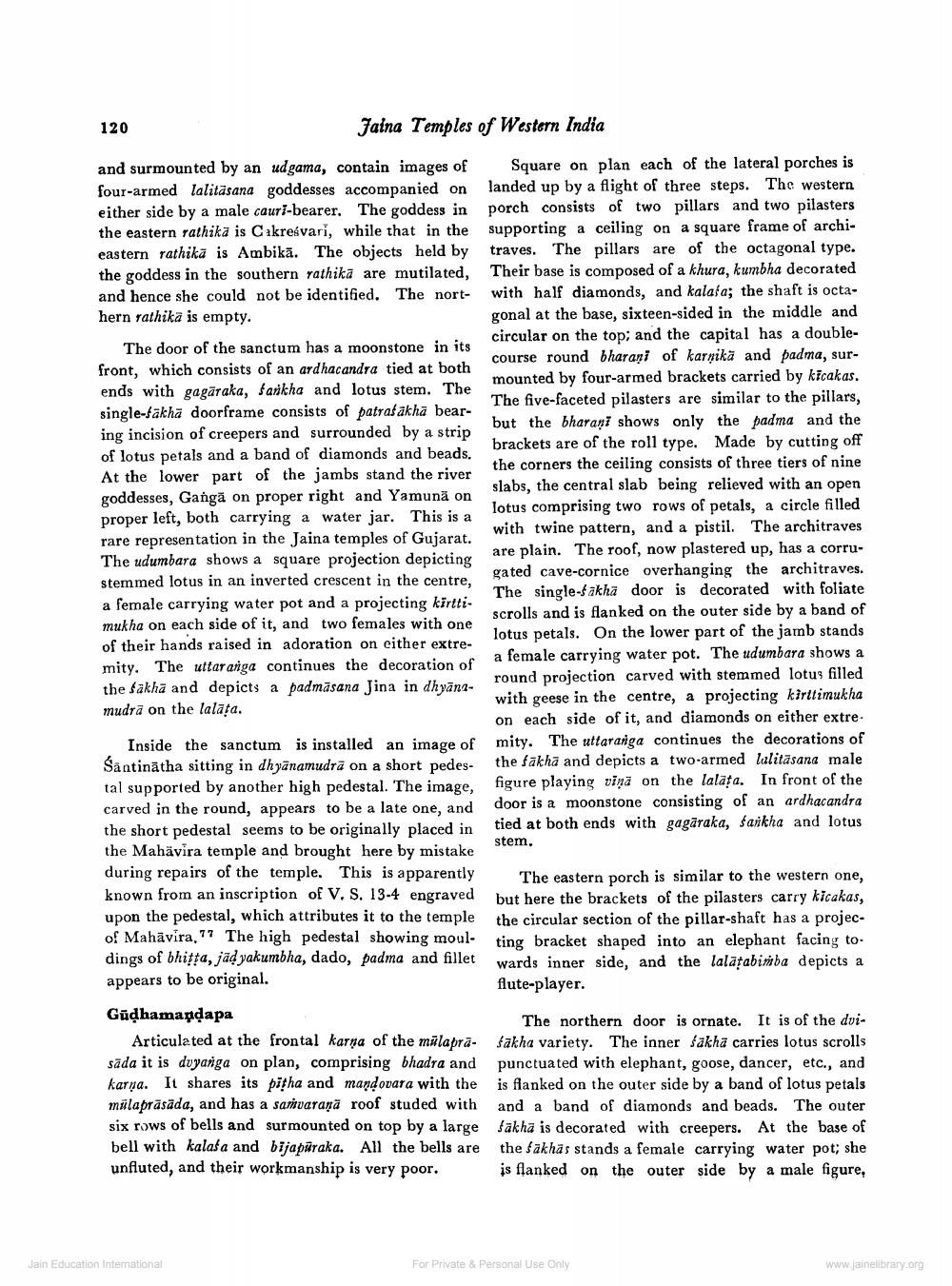________________
120
Jaina Temples of Western India
and surmounted by an udgama, contain images of four-armed lalitasana goddesses accompanied on either side by a male cauri-bearer. The goddess in the eastern rathika is Cakreśvari, while that in the eastern rathika is Ambika. The objects held by the goddess in the southern rathika are mutilated, and hence she could not be identified. The northern rathika is empty.
The door of the sanctum has a moonstone in its front, which consists of an ardhacandra tied at both ends with gagaraka, fankha and lotus stem. The single-fakha doorframe consists of patrasakha bearing incision of creepers and surrounded by a strip of lotus petals and a band of diamonds and beads. At the lower part of the jambs stand the river goddesses, Ganga on proper right and Yamuna on proper left, both carrying a water jar. This is a rare representation in the Jaina temples of Gujarat. The udumbara shows a square projection depicting stemmed lotus in an inverted crescent in the centre, a female carrying water pot and a projecting kirttimukha on each side of it, and two females with one of their hands raised in adoration on either extre
mity. The uttaranga continues the decoration of the Sakha and depicts a padmāsana Jina in dhyāna
mudra on the lalata.
Inside the sanctum is installed an image of Santinatha sitting in dhyanamudra on a short pedes tal supported by another high pedestal. The image, carved in the round, appears to be a late one, and the short pedestal seems to be originally placed in the Mahavira temple and brought here by mistake during repairs of the temple. This is apparently known from an inscription of V. S. 13-4 engraved upon the pedestal, which attributes it to the temple of Mahavira, 77 The high pedestal showing mouldings of bhiṭṭa, jad yakumbha, dado, padma and fillet appears to be original.
Gudhamanḍapa
Articulated at the frontal karṇa of the mulaprāsada it is duyanga on plan, comprising bhadra and karna. It shares its pitha and mandovara with the mülaprāsāda, and has a samvaraṇā roof studed with six rows of bells and surmounted on top by a large bell with kalasa and bijapuraka. All the bells are unfluted, and their workmanship is very poor.
Jain Education International
Square on plan each of the lateral porches is landed up by a flight of three steps. The western porch consists of two pillars and two pilasters supporting a ceiling on a square frame of architraves. The pillars are of the octagonal type. Their base is composed of a khura, kumbha decorated with half diamonds, and kalafa; the shaft is octagonal at the base, sixteen-sided in the middle and circular on the top; and the capital has a doublecourse round bharani of karnika and padma, surmounted by four-armed brackets carried by kīcakas. The five-faceted pilasters are similar to the pillars, but the bharani shows only the padma and the brackets are of the roll type. Made by cutting off the corners the ceiling consists of three tiers of nine slabs, the central slab being relieved with an open lotus comprising two rows of petals, a circle filled with twine pattern, and a pistil. The architraves are plain. The roof, now plastered up, has a corrugated cave-cornice overhanging the architraves. The single-fakha door is decorated with foliate scrolls and is flanked on the outer side by a band of lotus petals. On the lower part of the jamb stands a female carrying water pot. The udumbara shows a round projection carved with stemmed lotus filled with geese in the centre, a projecting kirttimukha
on each side of it, and diamonds on either extremity. The uttaranga continues the decorations of the fäkha and depicts a two-armed lalitäsana male figure playing vina on the lalata. In front of the door is a moonstone consisting of an ardhacandra. tied at both ends with gagāraka, sankha and lotus
stem.
The eastern porch is similar to the western one, but here the brackets of the pilasters carry kicakas, the circular section of the pillar-shaft has a projecting bracket shaped into an elephant facing to wards inner side, and the lalaṭabimba depicts a flute-player.
The northern door is ornate. It is of the duiśākha variety. The inner fakha carries lotus scrolls punctuated with elephant, goose, dancer, etc., and is flanked on the outer side by a band of lotus petals and a band of diamonds and beads. The outer fakha is decorated with creepers. At the base of the fakhas stands a female carrying water pot; she is flanked on the outer side by a male figure,
For Private & Personal Use Only
www.jainelibrary.org




